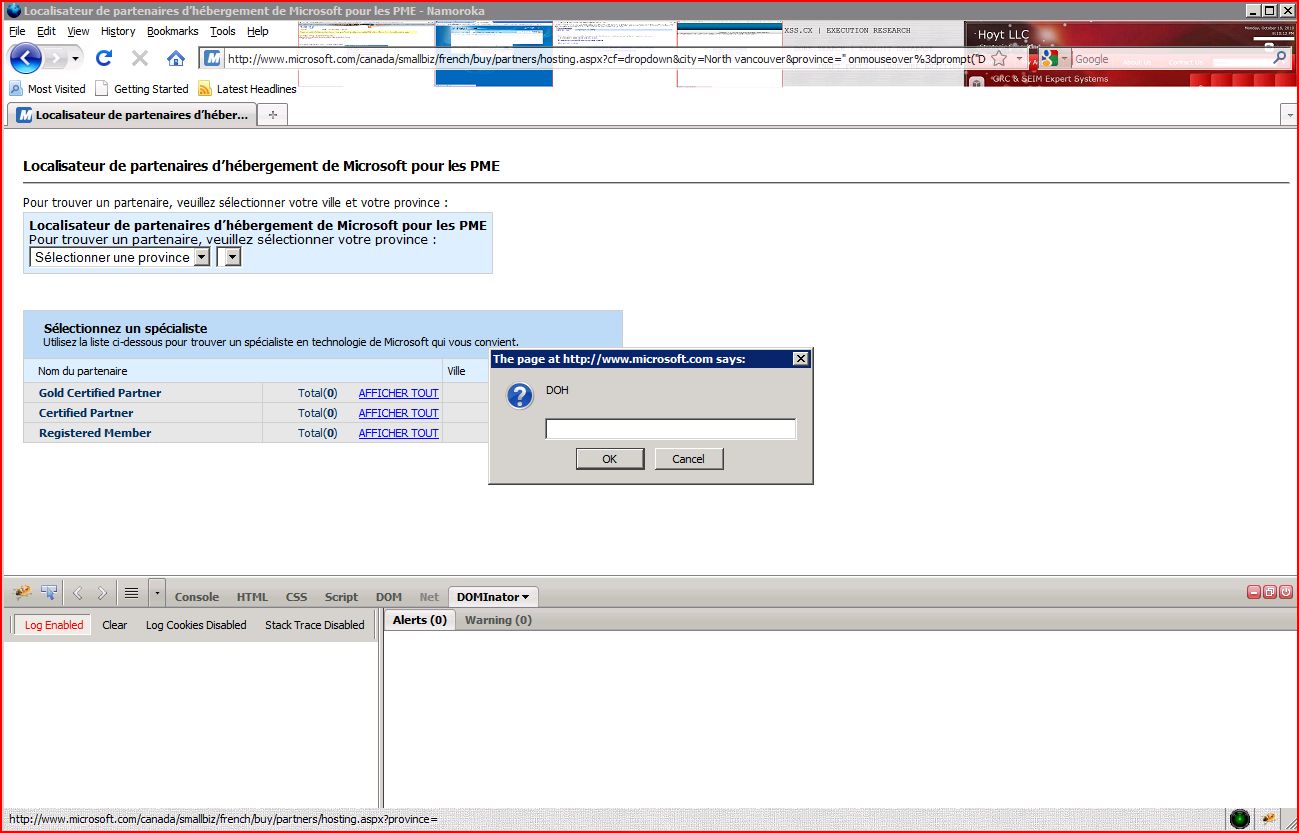1. Cross-site scripting (reflected)

1.1. http://www.microsoft.com/canada/smallbiz/french/buy/partners/hosting.aspx [city parameter]
1.2. http://www.microsoft.com/canada/smallbiz/french/buy/partners/hosting.aspx [province parameter]
| Severity: | High |
| Confidence: | Certain |
| Host: | http://www.microsoft.com |
| Path: | /canada/smallbiz/french |
| GET /canada/smallbiz/french Host: www.microsoft.com User-Agent: Mozilla/5.0 (Windows NT 6.1; WOW64) AppleWebKit/534.50 (KHTML, like Gecko) Version/5.1 Safari/534.50 Accept: text/html,application Origin: http://www.microsoft.com Accept-Encoding: gzip, deflate Accept-Language: en-US Referer: http://www.microsoft.com Cookie: A=I&I=AxUFAAAAAADPBw Pragma: no-cache Connection: keep-alive Proxy-Connection: keep-alive |
| HTTP/1.1 200 OK Cache-Control: private Content-Type: text/html; charset=utf-8 Vary: Accept-Encoding Server: Microsoft-IIS/7.5 X-AspNet-Version: 2.0.50727 VTag: 279914800300000000 P3P: CP="ALL IND DSP COR ADM CONo CUR CUSo IVAo IVDo PSA PSD TAI TELo OUR SAMo CNT COM INT NAV ONL PHY PRE PUR UNI" X-Powered-By: ASP.NET Date: Wed, 03 Aug 2011 20:42:52 GMT Content-Length: 10979 <!DOCTYPE HTML PUBLIC "-//W3C//DTD HTML 4.0 Transitional//EN" > <HTML> <HEAD> <title>Localisateur de partenaires d...h..bergement de Microsoft pour les PME</title> <meta content="M ...[SNIP]... <a href="http://www ...[SNIP]... |
| Severity: | High |
| Confidence: | Certain |
| Host: | http://www.microsoft.com |
| Path: | /canada/smallbiz/french |
| GET /canada/smallbiz/french Host: www.microsoft.com User-Agent: Mozilla/5.0 (Windows NT 6.1; WOW64) AppleWebKit/534.50 (KHTML, like Gecko) Version/5.1 Safari/534.50 Accept: text/html,application Origin: http://www.microsoft.com Accept-Encoding: gzip, deflate Accept-Language: en-US Referer: http://www.microsoft.com Cookie: A=I&I=AxUFAAAAAADPBw Pragma: no-cache Connection: keep-alive Proxy-Connection: keep-alive |
| HTTP/1.1 200 OK Cache-Control: private Content-Type: text/html; charset=utf-8 Vary: Accept-Encoding Server: Microsoft-IIS/7.5 X-AspNet-Version: 2.0.50727 VTag: 438481500400000000 P3P: CP="ALL IND DSP COR ADM CONo CUR CUSo IVAo IVDo PSA PSD TAI TELo OUR SAMo CNT COM INT NAV ONL PHY PRE PUR UNI" X-Powered-By: ASP.NET Date: Wed, 03 Aug 2011 20:42:48 GMT Content-Length: 10744 <!DOCTYPE HTML PUBLIC "-//W3C//DTD HTML 4.0 Transitional//EN" > <HTML> <HEAD> <title>Localisateur de partenaires d...h..bergement de Microsoft pour les PME</title> <meta content="M ...[SNIP]... <a href="http://www ...[SNIP]... |